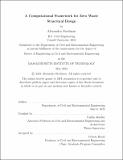A Computational Framework for Zero Waste Structural Design
Author(s)
Steelman, Alexandra
DownloadThesis PDF (23.17Mb)
Advisor
Mueller, Caitlin
Terms of use
Metadata
Show full item recordAbstract
Construction accounts for one third of the world’s waste, much of which can be attributed to inefficiencies in the design process – necessitating innovative approaches to structural design. In the typical design process a geometry is first determined, and then members are sized to its particular codes and requirements. Oftentimes, to satisfy these requirements, members are iteratively up-sized with the intention to alter them in order to fit within the geometry. By treating the geometry as fixed, this design approach assumes an infinite inventory of material and poorly utilizes total material volume. Instead of choosing the geometry of a project and then identifying members to fit within it, the design process can be improved by first determining the material quantity and then creating a geometry that uses the members most effectively. This material constrained approach has been applied in research such as circular design and beam shaping, but these applications do not address how to use all of the given inventory and thus still result in excess waste. In the furniture and fashion industries, a zero waste constraint has been applied to drive designs that are both functional and produce zero manufacturing waste. The goal of zero waste design is to devise a geometry that effectively uses all of the given material inventory and thus produces no waste in the process. That said, zero waste design has not been as widely applied for structures due to the added challenge of satisfying structural performance goals. This thesis accounts for both of these objectives by proposing a computational framework for zero waste structural design, specifically exploring a 2D domain of material and a target geometry of a pedestrian bridge. Four different computational methods have been applied to transform the material inventory, noted as the sheet domain, and the geometry, noted as the bridge domain. This thesis works with a 4’ x 8’ sheet domain and a bridge span of eight feet, but the methods are generalizable beyond these specific dimensions. The project investigates the structural performance of each possible result through an automated structural modeling and analysis workflow for assemblies of plate elements. The results shown in this thesis prove zero waste design is a viable approach to structural design, demonstrating there are both practical and effective applications for the developed framework.
Date issued
2022-05Department
Massachusetts Institute of Technology. Department of Civil and Environmental EngineeringPublisher
Massachusetts Institute of Technology